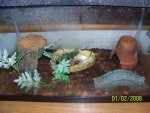ecoreptiles
New member
- Joined
- Aug 9, 2007
- Messages
- 50
- Reaction score
- 1
- Points
- 0
- Country
- Canada
I bought two T. shanjing at a reptile expo in mid November, and they haven't eaten anything!!! I've read all the other posts about this species, and I don't know where I'm going wrong. They probably are wild caught animals and I feel bad about that now.
They don't have any external problems, and they look like a healthy size. They move about a little bit at night.
They have refused small crickets and small waxworms repeatedly.
I have them in a 10 gallon tank with a gravel layer on the bottom and a mixed top substrate layer of cocoa fiber, reptibark, and sphagnum moss. I arranged little piles of each substrate separately and they choose the reptibark most often. They have a little hide cave and a shallow water dish that never get used. The temperature varies from 55-60'F. I'm not sure of the humidity level, but I'm sure it's over 65% and under 85%.
What can I do to make them happy?
They don't have any external problems, and they look like a healthy size. They move about a little bit at night.
They have refused small crickets and small waxworms repeatedly.
I have them in a 10 gallon tank with a gravel layer on the bottom and a mixed top substrate layer of cocoa fiber, reptibark, and sphagnum moss. I arranged little piles of each substrate separately and they choose the reptibark most often. They have a little hide cave and a shallow water dish that never get used. The temperature varies from 55-60'F. I'm not sure of the humidity level, but I'm sure it's over 65% and under 85%.
What can I do to make them happy?

